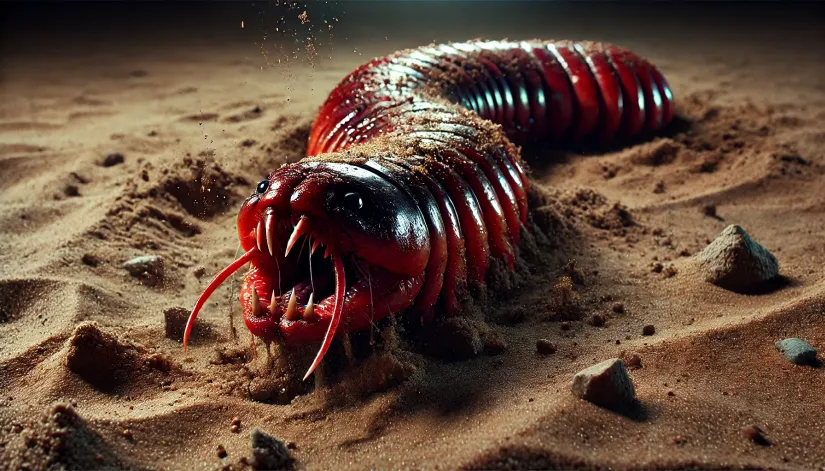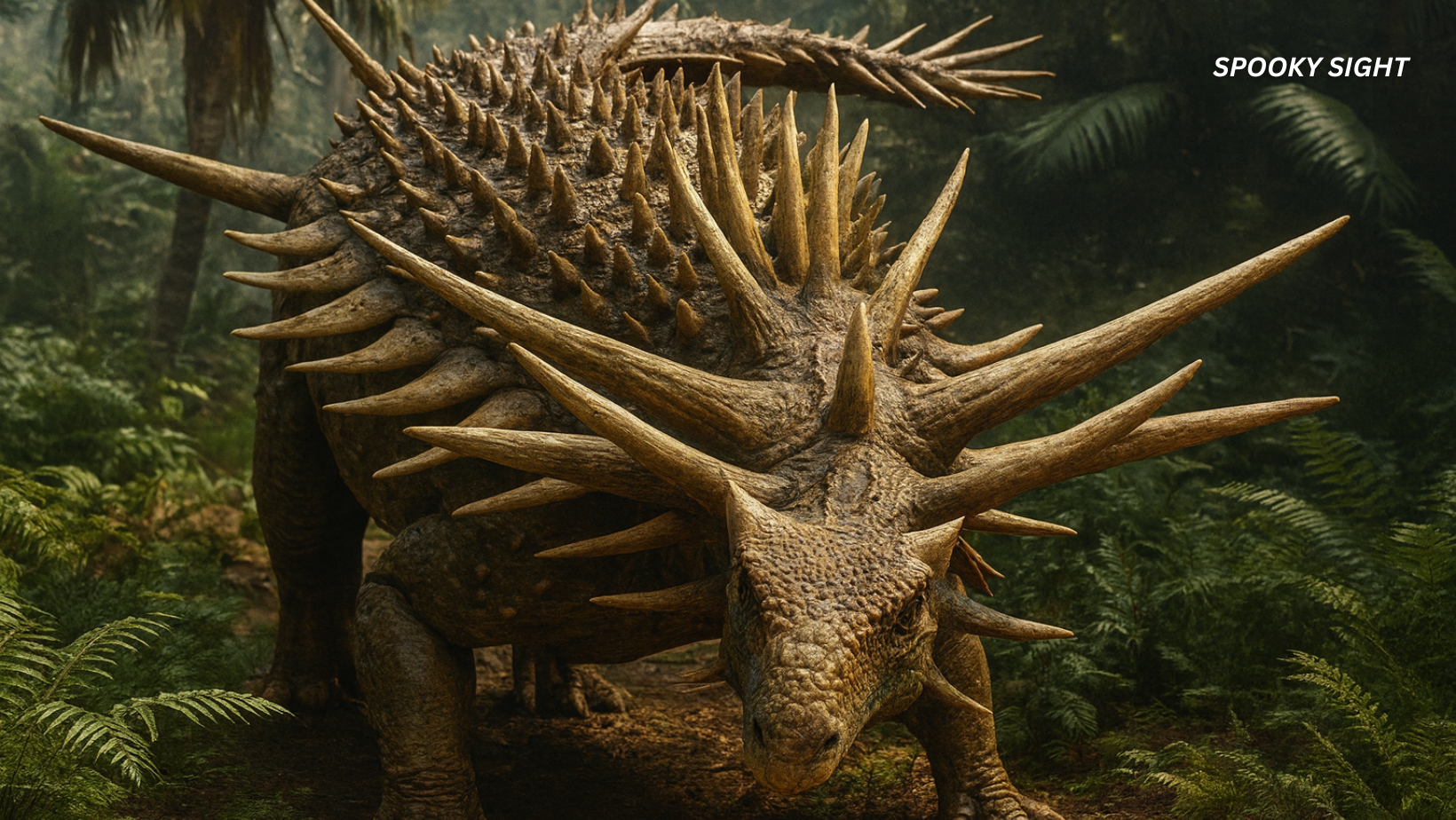The Mongolian Death Worm (also known as Allghoi Khorkhoi) is a strange underground cryptid believed to inhabit the vast and unforgiving expanse of the Gobi Desert.
However, despite many tales and alleged eyewitness reports, the existence of this strange creature remains largely unverified.
In this article:
The Mongolian Death Worm Legend
We don’t know when it all started. Instead, we know this strange Mongolian Death Worm legend has been passed down through generations among some of Mongolia’s nomadic tribes.
According to these oral traditions, the worm lurks beneath the sands of the Gobi Desert for most of its life. However, it may surface during the wetter months (June and July) to feed or when rain softens the sand, making it easier for the creature to move above ground.
The cryptid was first mentioned in the 1920s in the works of Roy Chapman Andrews—a renowned American explorer (who many believe inspired the famous movie character Indiana Jones).
Andrews—who led several expeditions to the Gobi Desert—was asked by Mongolian officials in 1919 to capture a specimen of the Allghoi Khorkhoi.
Although none of the officials had ever seen the creature themselves, they all believed in its existence and provided detailed descriptions.
Andrews agreed to keep an eye out for the worm, but despite his extensive explorations, he never encountered it.
Later, in the mid-20th century, under Mongolia’s communist regime, research (and even discussions about the worm) was reportedly banned. Why? No one knows for sure.
However, the unusual interdiction caused some cryptozoologists to wonder if there may be more to the story. Maybe it was something the communist regime was trying to hide?
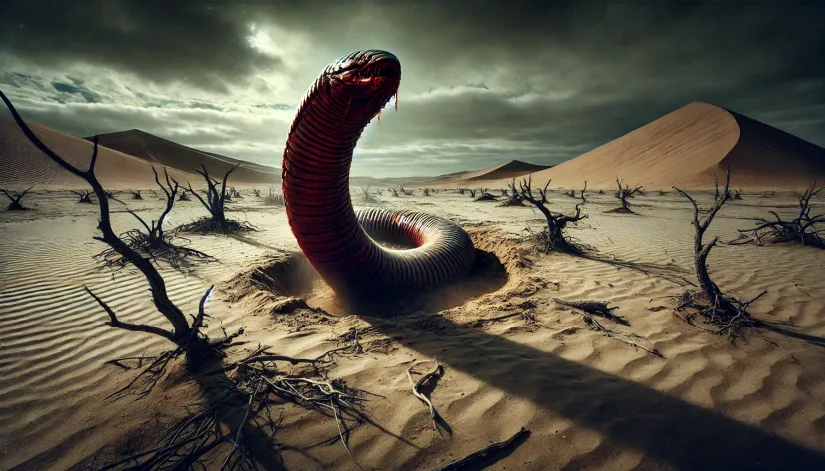
Physical Description and Alleged Abilities
The Gobi Desert—stretching across 500,000 square miles—is one of Earth’s most rugged and desolate landscapes.
This vast, mysterious territory has long beckoned explorers and adventurers, and its harsh conditions have fueled countless tales of undiscovered creatures.
The desert’s isolation and extreme environment make it a perfect backdrop for legends like the Mongolian Death Worm.
The Mongolian Death Worm is often described as a long, dark-red, sausage-shaped beast measuring about five to six feet long. It looks unlike any known animal, with spikes protruding from both ends of its body.
Interesting fact:
There are rumors that the Mongolian government once secretly investigated the existence of the Death Worm during the Soviet era. However, no official reports have ever been released.
The worm can move beneath the sands like a snake, leaving behind waves in the desert’s surface that betray its presence. In some stories, it inches along like a caterpillar. Or it moves with the speed and fluidity of a sidewinder.
In other accounts, the cryptid is described as blood-red, resembling the intestines of a cow. Which is likely how it reportedly earned its name—Allghoi Khorkhoi roughly translates to “intestine worm.”
SpookySight recommends:
- Impundulu: The Lightning Bird African Cryptid That Will Shock You
- Is the Almas a Relict Hominid? Theories, Sightings, and Modern Expeditions
- Is the Loch Ness Monster Real? What We Really Know
Some tales even depict the worm with wings, capable of briefly flying when it is agitated. These are vastly exaggerated.
But what makes this cryptid truly terrifying are its supposed deadly abilities.
According to local legends, the Mongolian Death Worm can spit venom potent enough to corrode metal and kill on contact. Even more fantastical is the claim that it can generate electric shocks powerful enough to instantly kill an adult human.
These deadly attributes, combined with its evasive nature, make the Mongolian Death Worm one of the most feared and well-known Asian cryptids.
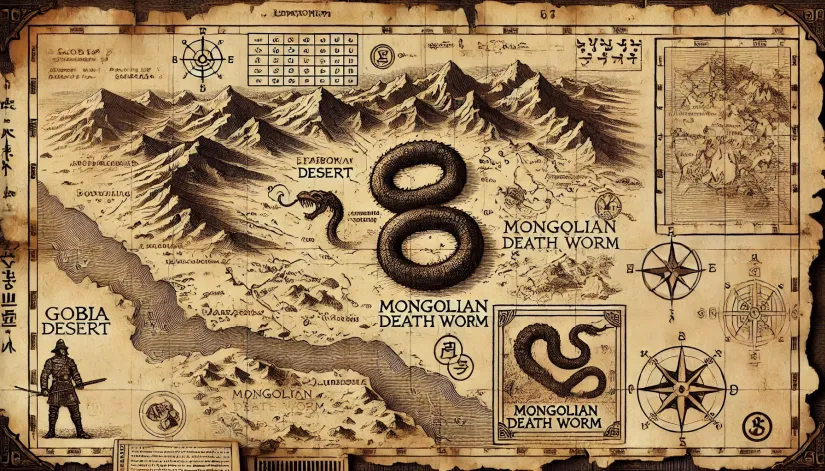
Expeditions and Attempts to Uncover the Truth
As you can expect, the Mongolian Death Worm has captured the imagination of many cryptid hunters over the years. Some have even dedicated years of their lives to finding the mysterious cryptid.
One of the most devoted and persistent investigators was Czech cryptozoologist Ivan Mackerle, an automotive designer turned adventurer.
Ivan Mackerle’s 1990 Expedition: The Thumper Experiment
Mackerle’s fascination with the worm led him to organize three separate expeditions to Mongolia, beginning in 1990—just weeks after Mongolia’s democratic revolution.
With a Soviet ATV, a team of Czechs, and local guides, Mackerle ventured into the most remote corners of the Gobi Desert.
For two months, the team methodically traversed the harsh desert landscape, focusing on areas where local nomads claimed the worm was most active.
Related: Is the Lizard Man of Scape Ore Swamp Real? Evidence and Sightings
At temperatures up to 122 degrees Fahrenheit, Mackerle’s team used a “thumper”—a device inspired by the “Dune” novels where the planet’s fictional giant sandworms were summoned by similar vibrations—to create rhythmic vibrations that might lure the worm to the surface.
Despite their efforts and the careful deployment of the thumper in various locations, Mackerle found absolutely no physical evidence of the creature.
The 1992 Expedition: Explosive Tactics
Undeterred by the lack of results from his first attempt, Mackerle returned to the Gobi Desert in 1992 with a new, more aggressive approach.
Learning from his previous attempt to lure the Mongolian Death Worm to the surface using a motor-driven “thumper,” Mackerle decided to up the game by mixing small explosives into his strategy.
Related:
- Is the Grootslang Real? Discover The Legendary Beast of Africa
- Is the Flatwoods Monster Real? An In-Depth Investigation of the 1952 Sighting
- The Rake Monster: Creepypasta’s Most Terrifying Urban Legend?
The idea was that the vibrations and shockwaves from these controlled explosions might provoke the cryptid to emerge from its subterranean hiding spots.
And so they did. The team chose some areas where local sightings had been reported and started detonating.
But again, despite the meticulous planning and the daring nature of the experiment, this expedition, like the first, ended without any concrete evidence of the Allghoi Khorkhoi. No sightings were reported, and the team came up empty-handed.
The 2004 Aerial Survey
In 2004, Merkerle returned and tried another tactic: an aerial survey. This time, he received help from ultralight pilot Jiří Zítka.
For three weeks, they flew a small aircraft with video cameras to survey the vast dunes and scrublands of the Gobi from above. It was a smart approach since some alleged worm sightings were reported in areas almost inaccessible by foot or vehicle.
Sadly, despite this expedition’s technological advancements and a much broader reach, no sightings or evidence of the Mongolian Death Worm were recorded. The aerial survey, like Mackerle’s earlier efforts, ended in disappointment.
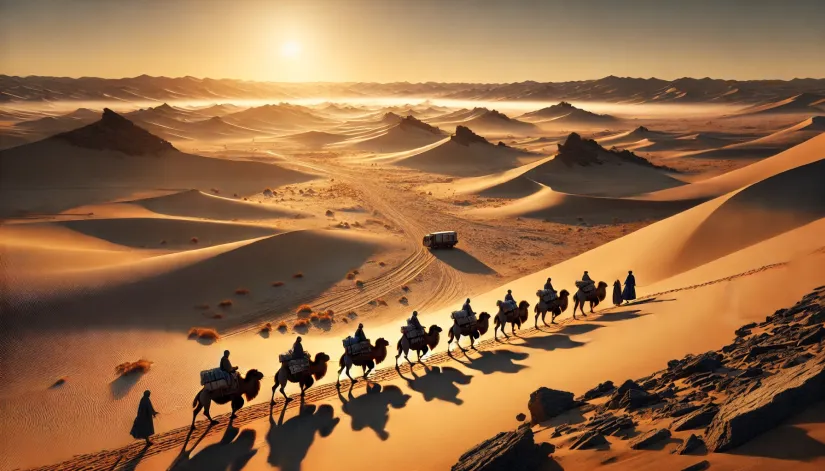
The 2005 CFZ Expedition: Richard Freeman’s Search
Expeditions in search of the Mongolian Sand Worm were not unique to Mackerle.
Over the years, numerous other teams—including groups from the U.S., Britain, and New Zealand—have launched their own searches for the Mongolian Death Worm.
For instance, the Center for Fortean Zoology (CFZ), a British cryptozoology research group, organized its own expedition in 2005 led by Richard Freeman.
Freeman’s approach was somewhat different from that of previous expeditions. While Ivan Mackerle had focused on technology and dramatic methods, Freeman strongly emphasized engaging with the local tribes.
Freeman’s team, which included a physicist, a science writer, and an artist, traveled deep into the desert, visiting remote areas and speaking to locals who claimed to have encountered the creature.
Related: Tatzelwurm: The Alpine Cryptid You’ve Never Heard Of
They even distributed flyers across the Gobi Desert (offering rewards for any information or specimens) and commissioned artwork of the worm to show to locals, hoping to jog memories or elicit stories of sightings.
The CFZ’s efforts were extensive, spanning four weeks in May 2005. The team recorded several intriguing firsthand accounts from locals, most of which described short, brown-scaled, boa-like creatures—suggesting that the worm might be based on the Tartar sand boa.
One such story came from a 90-year-old former policeman who claimed to have seen the creature in 1930.
Despite these anecdotal reports, no physical evidence of the Mongolian Death Worm was found. Like many before them, the CFZ team left the Gobi without conclusive proof of the creature’s existence.
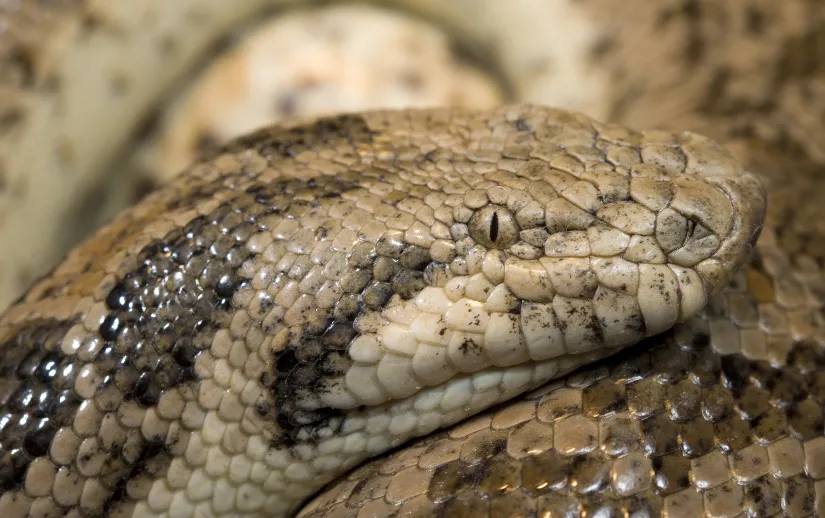
Debunking and Theories
In 1983, Soviet scientist Yuri Gorelov proposed that the Mongolian Death Worm might be based on sightings of the Tartar sand boa (a harmless, burrowing snake native to the region).
Gorelov’s theory gained traction after he visited a local Mongolian man who claimed to have captured the worm. When Gorelov arrived, he found that the creature was indeed a Tartar sand boa.
According to Gorelov, the locals identified this non-venomous snake with rounded heads and gray-brown scales as the Allghoi Khorkhoi.
Folklorist Ágnes Birtalan from Hungary’s Eötvös Loránd University also supports this theory. He notes that in Mongol cultures, the word “khorkhoi” (meaning “worm”) is a “taboo name” often used for animals considered dangerous—particularly snakes.
Did you know?
One hypothesis suggests that if the Mongolian Death Worm does exist, it might generate an electromagnetic field strong enough to disrupt electronic devices—a theory that could explain why modern technology has failed to capture evidence of the creature.
This idea suggests that the Mongolian Death Worm legend may have evolved from actual encounters with the Tartar sand boa, misunderstood and exaggerated over time.
Birtalan also pointed out that “khorkhoi” has historically referred to animals with both metaphysical and literal dangers (reinforcing the idea that the worm could be a mix of reality and myth).
However, many cryptozoologists, including Karl Shuker and Ivan Mackerle, reject this explanation.
In his books “The Beasts That Hide from Man” and “The Unexplained: An Illustrated Guide to the World’s Natural And Paranormal Mysteries” Shuker argues that such a vivid and terrifying legend could not have arisen around a known and relatively harmless snake.
The descriptions of the Allghoi Khorkhoi, he contends, are far too specific and terrifying to be about the Tartar sand boa.
Mackerle echoed this sentiment, stating that Mongolian herders (familiar with the local fauna) would not mistake a common snake for a creature as feared and revered as the Death Worm.
To make things even more interesting, some locals believe the worm is not even a living creature. But a supernatural entity.
In 1992, during Mackerle’s 2nd expedition, he allegedly met with a local shaman who warned him that the worm was not merely a creature of flesh and blood, but a “demon of the desert.”
The shaman urged Mackerle to respect local taboos. He also warned that any attempt to hunt or capture the worm could incur its wrath, leading to dire consequences.
Is the Mongolian Death Worm Real?
We believe it could be… but with some caveats. And here’s why:
First, despite many expeditions and scientific investigations, no concrete evidence has been found to confirm the existence of this creature. No body, skeleton, or even a credible photograph of the worm. Nothing. Just a bunch of fantastic claims from the few local tribes—all very superstitious people.
From a scientific perspective, we have several reasons to doubt the existence of the Mongolian Death Worm.
For example, the extreme environment of the Gobi Desert is not conducive to a large, fleshy creature like the one described in the legends.
The Gobi Desert, known for its harsh and unforgiving climate, is one of the most inhospitable places on Earth. It experiences extreme temperature fluctuations, ranging from scorching heat in the summer to freezing cold in the winter.
These conditions make it unlikely for a creature of the size and type described in the legends to survive.
Plus, many cryptozoologists believe that the Mongolian Death Worm stories could be exaggerated accounts of encounters with known species (such as the Tartar sand boa) or perhaps even a product of the region’s rich folklore and the human tendency to create myths about the unknown.
We 100% agree with that. Now, here’s the caveat:
Gobi Desert’s 500,000 square miles remain largely unexplored, especially in its more remote regions. Could there be unknown animal species in these isolated landscapes? Yes.
If such a creature lived in the Gobi, it would likely have adapted to the harsh environment by burrowing beneath the sand to escape the sun and heat. So, from this perspective, the legend does make some sense. And it might hold a kernel of truth.
Frequently Asked Questions
What is the Mongolian Death Worm?
The Mongolian Death Worm, or Allghoi Khorkhoi, is a cryptid said to inhabit the Gobi Desert. It’s described as a red, sausage-shaped worm with deadly abilities, including venomous spit and electric shocks.
What does the Mongolian Death Worm eat?
The diet of the Mongolian Death Worm is unknown, as its existence has not been scientifically verified. Legends suggest it may prey on livestock and possibly humans.
How big is the Mongolian Death Worm?
The creature is rumored to be about five to six feet long, though some stories suggest it can grow even larger.
Where does the Mongolian Death Worm live?
According to legend, the worm lives beneath the sands of the Gobi Desert, only surfacing during the wettest months.

